 ResearchSpace
ResearchSpace
Effects of substrate heating on the microstructure and hardness of TiB/Ti6Al4V-ELI during laser in-situ metal deposition
JavaScript is disabled for your browser. Some features of this site may not work without it.
- ResearchSpace
- →
- Research Publications/Outputs
- →
- Journal Articles
- →
- View Item
| dc.contributor.author |
Lekoadi, Paul M

|
|
| dc.contributor.author |
Tlotleng, Monnamme

|
|
| dc.contributor.author |
Masina, Bathusile N

|
|
| dc.date.accessioned | 2022-04-19T10:17:23Z | |
| dc.date.available | 2022-04-19T10:17:23Z | |
| dc.date.issued | 2021-12 | |
| dc.identifier.citation | Lekoadi, P.M., Tlotleng, M. & Masina, B.N. 2021. Effects of substrate heating on the microstructure and hardness of TiB/Ti6Al4V-ELI during laser in-situ metal deposition. <i>South African Journal for Science and Technology, 40(1).</i> http://hdl.handle.net/10204/12374 | en_ZA |
| dc.identifier.issn | 0254-3486 | |
| dc.identifier.issn | 2222-4173 | |
| dc.identifier.uri | https://doi.org/10.36303/SATNT.2021cosaami.12 | |
| dc.identifier.uri | http://hdl.handle.net/10204/12374 | |
| dc.description.abstract | This work investigated the influence of heating temperature (°C) on the microstructure and microhardness of TiB/Ti6Al4V-ELI composite clads that were produced via in-situ alloying using laser metal deposition technique. The samples were produced on a Ti6Al4V base plates which were heated at different temperatures (25°C, 200°C, 300°C, 400°C and 500°C) before they were characterised for microstructure and hardness. It was found that the TiB/Ti6Al4V-ELI sample that was produced on a non-pre-heated base plate was characterized by TiB particles and had the lowest hardness of 511 ± 66 HV. Base plate heating resulted in the formation of TiB whiskers that were dispersed within the titanium matrix. 200°C led to a microstructure with clusters of TiB whiskers hence it had an increased hardness of 651 ± 40 HV. A fine microstructure with homogeneous distribution of the TiB whiskers was obtained at 500°C base plate heating temperature and had hardness of 565 ± 14 HV. | en_US |
| dc.format | Fulltext | en_US |
| dc.language.iso | en | en_US |
| dc.relation.uri | https://cosaami.co.za/wp-content/uploads/2021/09/2021-CoSAAMI-Programme.pdf | en_US |
| dc.source | South African Journal for Science and Technology, 40(1) | en_US |
| dc.subject | TiB/Ti6Al4V-ELI composite clads | en_US |
| dc.title | Effects of substrate heating on the microstructure and hardness of TiB/Ti6Al4V-ELI during laser in-situ metal deposition | en_US |
| dc.type | Article | en_US |
| dc.description.pages | 6pp | en_US |
| dc.description.cluster | Manufacturing | en_US |
| dc.description.impactarea | Laser Enabled Manufacturing | en_US |
| dc.identifier.apacitation | Lekoadi, P. M., Tlotleng, M., & Masina, B. N. (2021). Effects of substrate heating on the microstructure and hardness of TiB/Ti6Al4V-ELI during laser in-situ metal deposition. <i>South African Journal for Science and Technology, 40(1)</i>, http://hdl.handle.net/10204/12374 | en_ZA |
| dc.identifier.chicagocitation | Lekoadi, Paul M, Monnamme Tlotleng, and Bathusile N Masina "Effects of substrate heating on the microstructure and hardness of TiB/Ti6Al4V-ELI during laser in-situ metal deposition." <i>South African Journal for Science and Technology, 40(1)</i> (2021) http://hdl.handle.net/10204/12374 | en_ZA |
| dc.identifier.vancouvercitation | Lekoadi PM, Tlotleng M, Masina BN. Effects of substrate heating on the microstructure and hardness of TiB/Ti6Al4V-ELI during laser in-situ metal deposition. South African Journal for Science and Technology, 40(1). 2021; http://hdl.handle.net/10204/12374. | en_ZA |
| dc.identifier.ris | TY - Article AU - Lekoadi, Paul M AU - Tlotleng, Monnamme AU - Masina, Bathusile N AB - This work investigated the influence of heating temperature (°C) on the microstructure and microhardness of TiB/Ti6Al4V-ELI composite clads that were produced via in-situ alloying using laser metal deposition technique. The samples were produced on a Ti6Al4V base plates which were heated at different temperatures (25°C, 200°C, 300°C, 400°C and 500°C) before they were characterised for microstructure and hardness. It was found that the TiB/Ti6Al4V-ELI sample that was produced on a non-pre-heated base plate was characterized by TiB particles and had the lowest hardness of 511 ± 66 HV. Base plate heating resulted in the formation of TiB whiskers that were dispersed within the titanium matrix. 200°C led to a microstructure with clusters of TiB whiskers hence it had an increased hardness of 651 ± 40 HV. A fine microstructure with homogeneous distribution of the TiB whiskers was obtained at 500°C base plate heating temperature and had hardness of 565 ± 14 HV. DA - 2021-12 DB - ResearchSpace DP - CSIR J1 - South African Journal for Science and Technology, 40(1) KW - TiB/Ti6Al4V-ELI composite clads LK - https://researchspace.csir.co.za PY - 2021 SM - 0254-3486 SM - 2222-4173 T1 - Effects of substrate heating on the microstructure and hardness of TiB/Ti6Al4V-ELI during laser in-situ metal deposition TI - Effects of substrate heating on the microstructure and hardness of TiB/Ti6Al4V-ELI during laser in-situ metal deposition UR - http://hdl.handle.net/10204/12374 ER - | en_ZA |
| dc.identifier.worklist | 25455 | en_US |





